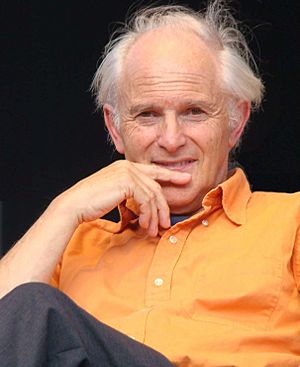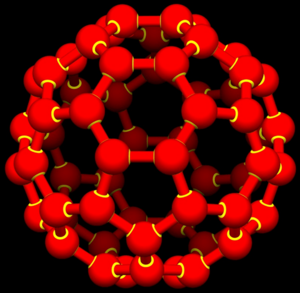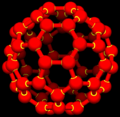Harry Kroto facts for kids
Quick facts for kids
Sir
Harry Kroto
|
|
|---|---|

Kroto in 2010
|
|
| Born |
Harold Walter Krotoschiner
7 October 1939 Wisbech, Cambridgeshire, England
|
| Died | 30 April 2016 (aged 76) Lewes, East Sussex, England
|
| Education | Bolton School |
| Alma mater | University of Sheffield |
| Known for | Buckminsterfullerene |
| Spouse(s) |
Margaret Henrietta Hunter
(m. 1963) |
| Children | 2 |
| Awards |
|
| Scientific career | |
| Fields | Chemistry |
| Institutions |
|
| Thesis | The spectra of unstable molecules under high resolution (1964) |
| Doctoral students | Perdita Barran |
| Influences | Harry Heaney |
Sir Harold Walter Kroto (born Harold Walter Krotoschiner; 7 October 1939 – 30 April 2016), known as Harry Kroto, was an English chemist. He won the 1996 Nobel Prize in Chemistry with Robert Curl and Richard Smalley. They earned this award for finding fullerenes, a new form of carbon. Harry Kroto received many other awards and honors during his life.
He worked as a chemistry professor at Florida State University from 2004 until his death. Before that, he spent about 40 years teaching and researching at the University of Sussex in England. Kroto was also a strong supporter of science education.
Contents
Early Life and Interests
Harry Kroto was born in Wisbech, England. His parents, Edith and Heinz Krotoschiner, were from Berlin, Germany. They moved to Great Britain in the 1930s to escape Nazi Germany. His father was Jewish. Harry grew up in Bolton while his father was held on the Isle of Man during World War II. Harry went to Bolton School, where he was in the same class as actor Ian McKellen. In 1955, his father changed the family name to Kroto.
As a child, Harry loved a Meccano set, which is like an advanced building toy. He believed that playing with Meccano and helping his father in his balloon factory helped him develop skills useful for science. He became very interested in chemistry, physics, and mathematics in high school. His chemistry teacher, Harry Heaney, suggested he go to the University of Sheffield. This teacher thought Sheffield had the best chemistry department in the UK.
Although he was raised Jewish, Harry Kroto said that religion never made sense to him. He was a humanist, meaning he focused on human values and reason. He was a strong supporter of the British Humanist Association. In 2003, he was one of 22 Nobel winners who signed the Humanist Manifesto. This document shares humanist beliefs.
In 2015, Kroto signed the Mainau Declaration 2015 on Climate Change. This declaration was signed by 76 Nobel winners. It was given to the French President as part of the COP21 climate summit.
Education and Research
University Studies
Kroto studied at Bolton School and then at the University of Sheffield starting in 1958. He earned a top degree in Chemistry in 1961 and a PhD in Molecular Spectroscopy in 1964. During his time at Sheffield, he was also the art editor for the university magazine. He played tennis for the university team and was president of the Student Athletics Council.
His PhD research included studying carbon suboxide. This made him interested in molecules with long chains of carbon atoms. He first liked organic chemistry, but then became interested in quantum chemistry after learning about spectroscopy. Later, he also became interested in astrochemistry, which is the study of chemicals in space.
After his PhD, Kroto worked as a researcher in Canada and at Bell Labs in New Jersey. He studied molecules using different scientific methods.
Discoveries at Sussex University
In 1967, Kroto started teaching and doing research at the University of Sussex in England. He focused on studying new and unstable molecules. His work led to new types of chemistry involving carbon bonded to other elements like sulfur, selenium, and phosphorus. A big step forward was creating new phosphorus molecules with his colleague John Nixon. This led to the study of phosphaalkenes and phosphaalkynes, which have carbon double and triple bonded to phosphorus.
In 1975, he became a full professor of Chemistry. Around this time, he worked with David Walton to study long carbon chain molecules. They used radio telescopes with Canadian astronomers. They surprisingly found that these unusual carbon molecules exist in large amounts in space. They were found in interstellar space and in the outer parts of certain stars, like carbon-rich red giants.
Finding Buckminsterfullerene
In 1985, based on their work at Sussex and the space discoveries, Kroto and his team did experiments. They worked with James R. Heath, Sean C. O'Brien, Yuan Liu, Robert Curl, and Richard Smalley at Rice University. They used lasers to vaporize graphite, which is a form of carbon. They found that stable C60 molecules could form on their own from carbon vapor.
The C60 molecule looks like a tiny football. It has 12 pentagons and 20 hexagons made of carbon atoms. Kroto named it buckminsterfullerene after Buckminster Fuller. Fuller was famous for designing geodesic domes, and the dome shape helped Kroto understand the molecule's structure.
This discovery was very important because it found a new form of carbon, called a fullerene. Other forms of carbon include graphite, diamond, and graphene. The 1985 paper about C60 was recognized with a Chemical Breakthrough Award. The discovery of fullerenes was also named a National Historic Chemical Landmark in 2010.
Later Research and Outreach
In 2004, Kroto moved to Florida State University. There, he continued his research on carbon and tiny structures called nanostructures. He also studied how fullerenes and other carbon molecules form in space.
He was very active in science education. In 1995, he helped start the Vega Science Trust. This charity made high-quality science films, including lectures by Nobel winners. These films were available for free online. The trust closed in 2012.
In 2009, Kroto started another science education project called Geoset. GEOSET is an online collection of recorded teaching videos. These videos are free for teachers and the public. The goal is to share science knowledge by creating a global library of educational videos from top universities.
Kroto also spoke at many events and universities around the world. He believed that scientists should work for the good of everyone. He was a strong supporter of Amnesty International, which works for human rights. He also praised the growth of online information, calling it an "Educational Revolution" and the "GooYouWiki" world (referring to Google, YouTube, and Wikipedia).
Personal Life and Beliefs
In 1963, Harry Kroto married Margaret Henrietta Hunter. They had two sons, Stephen and David. Harry loved film, theater, art, and music throughout his life. He also created his own artwork.
Kroto was an atheist, meaning he did not believe in a god. He thought that beliefs about living forever came from a fear of death. He was a patron of the British Humanist Association. He believed that religious rules could sometimes make people accept actions that were not kind or fair. He felt that scientists had a duty to help all people.
Graphic Design Work
Even though he became famous for his science, Kroto also loved graphic design. He had done design work semi-professionally for many years. The discovery of buckminsterfullerene made him put off his dream of opening an art and graphic design studio. However, his design skills led to many posters, logos, and book covers. He even designed the Nobel UK Stamp for Chemistry in 2001.
Death
Harry Kroto passed away on 30 April 2016, in Lewes, England. He was 76 years old and died from complications of amyotrophic lateral sclerosis, a serious illness that affects nerve cells.
Friends and colleagues remembered him as a brilliant scientist with a great sense of humor. They noted his passion for science education and his strong belief in critical thinking.
Awards and Honors
Harry Kroto received many important awards for his work:
- Tilden Lecturer of the Royal Society of Chemistry, 1981–82
- Elected a Fellow of the Royal Society (FRS) in 1990
- International Prize for New Materials American Physical Society, 1992 (with Robert Curl and Richard Smalley)
- Nobel Prize in Chemistry, 1996 (shared with Robert Curl and Richard Smalley)
- Carbon Medal, American Carbon Society Medal for Achievement in Carbon Science, 1997 (shared with Robert Curl and Richard Smalley)
- Dalton Medal (Manchester Lit and Phil), 1998
- Faraday Award and Lecture (Royal Society), 2001
- Copley Medal of the Royal Society, 2002
- Golden Plate Award of the American Academy of Achievement, 2002
- Foreign Associate of the National Academy of Sciences, 2007
- National Historic Chemical Landmark, American Chemical Society, 2010.
- Citation for Chemical Breakthrough Award, Division of History of Chemistry, American Chemical Society, 2015
He was made a Knight Bachelor in 1996, which means he received the title "Sir."
The University of Sheffield has two buildings named after Kroto: The Kroto Innovation Centre and the Kroto Research Institute.
Honorary Degrees
Harry Kroto received many honorary degrees from universities around the world. These degrees recognize his great achievements and contributions to science. Some of the universities that honored him include:
- Université Libre de Bruxelles (Belgium)
- University of Stockholm (Sweden)
- University of Sheffield (UK)
- University of Sussex (UK)
- University of Helsinki (Finland)
- University of Nottingham (UK)
- Yokohama City University (Japan)
- University of Aberdeen (Scotland)
- University of Leicester (UK)
- University of Aveiro (Portugal)
- University of Bielefeld (Germany)
- University of Hull (UK)
- Manchester Metropolitan University (UK)
- Hong Kong City University (HK China)
- University College London (UK)
- University of Patras (Greece)
- University of Manchester (UK)
- AGH University of Science and Technology in Kraków (Poland)
- University of Durham (UK)
- Queens University Belfast (NI)
- University of Surrey (UK)
- Polytechnico di Torino (Italy)
- University of Liverpool (UK)
- Florida Southern College (US)
- Keio University (Japan)
- University of Chiba (Japan)
- University of Bolton (UK)
- University of Hartford (US)
- University of Tel Aviv (Israel)
- University of Poitiers (France)
- Universidad Complutense de Madrid
- Naresuan University (Thailand)
- Vietnam National University (Hanoi)
- University of Edinburgh (Scotland)
- University of Primorska (Slovenia)
Images for kids
See also
 In Spanish: Harold Kroto para niños
In Spanish: Harold Kroto para niños




